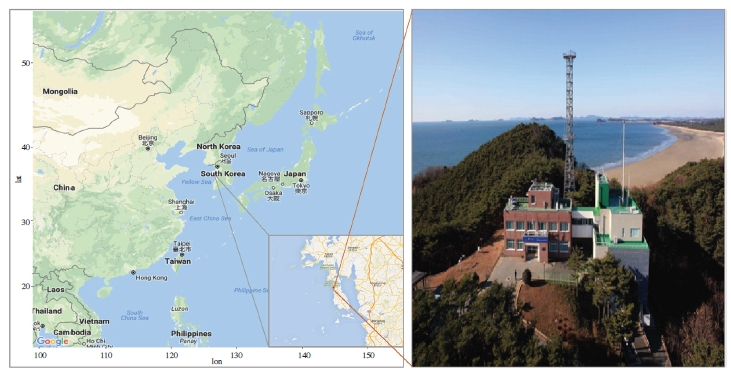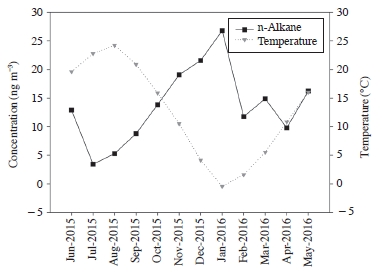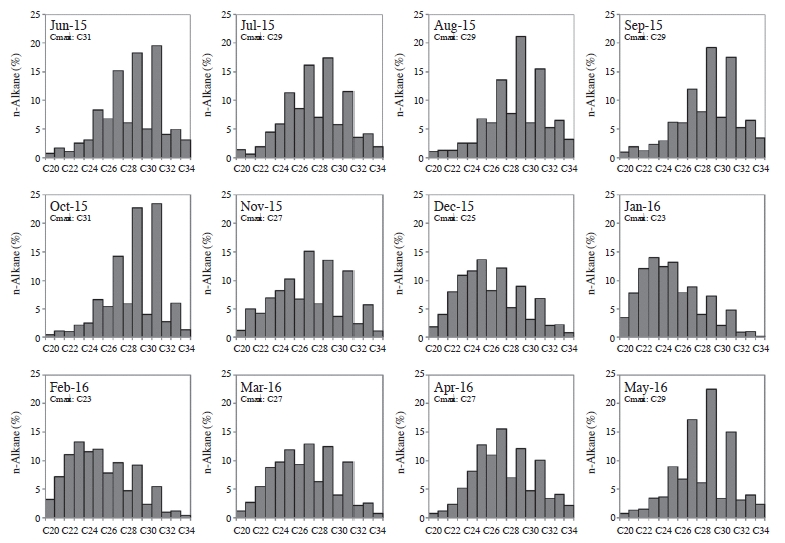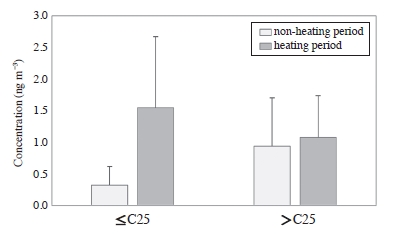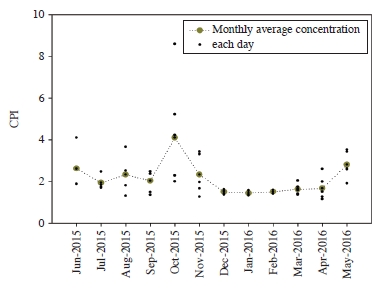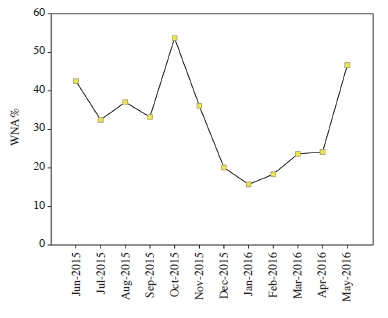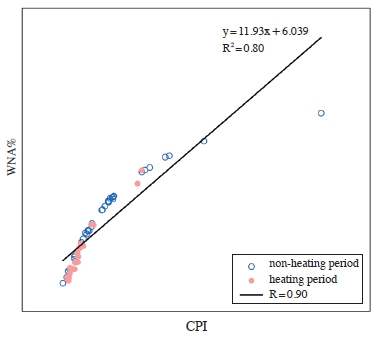
안면도 대기 중 PM2.5 내 n-alkanes의 월별 농도 분포 특성
Copyright © 2018 Korean Society for Atmospheric Environment
Abstract
The n-alkanes which are stable compounds in the atmosphere are emitted by anthropogenic sources and biological sources. The goal of this study is to understand characteristics of n-alkane distributions in PM2.5 of the Anmyeon Island which is one of background site in Korea. The concentration of n-alkanes in PM2.5 was measured at Anmyeon Island for one year from June 2015 to May 2016. The average concentration of total n-alkanes ( Σ n-alkanes) from C20 to C34 was 14.02±10.26 ng m-3 and ranged from 1.77 to 47.65 ng m-3. Various diagnostic parameters were used to identify the source. As a result, it is considered that Anmyeon Island had a large influence of biological sources during non-heating period, while the influence of anthropogenic emission during the heating period was significant. Principle Component Analysis (PCA) was performed and yielded three components that accounted for 93.6% of the total variance in n-alkanes. Factor 1, which accounted for 42.3% of the total variance, indicated anthropogenic source including fossil fuel and biomass combustion, while, Factor 3 was interpreted as the biological sources such as plant wax.
Keywords:
PM2.5, n-Alkanes, Anmyeon Island, CPI, PCA1. 서 론
n-Alkanes은 탄소수에 따라 대기 중에 기체 또는 입자로 존재하는 반 휘발성 유기화합물 (Semi-Volatile-Organic Compounds, SVOCs)로, 일반적으로 탄소수가 20개 이상 (>C20)인 n-alkane부터는 주로 대기 먼지에 존재한다. 대기 중 n-alkane은 화학 반응성이 낮기 때문에 이들의 배출 상태에 대한 정보를 유지할 수 있다. n-Alkane의 주요 배출원으로는 화석연료 또는 바이오매스 연소에서 비롯되는 인위적 배출원과 식물 표면의 왁스 (plant wax)로부터 비롯되거나 꽃가루, 미생물 (박테리아, 곰팡이) 및 곤충에서 방출되는 입자에서 비롯되는 자연적 생성으로 구분된다 (Bi et al., 2003; Yassaa et al., 2001; Fraser et al., 1999; Limbeck and Puxbaum, 1999; Rogge et al., 1993; Simoneit, 1977; Simoneit and Eglinton, 1977). 이러한 n-alkane의 인위적 배출 또는 자연적 생성 특성 구분은 n-alkane 성분들의 탄소수에 따른 농도 분포 특성으로 구분할 수 있다 (Kadowaki, 1994; Rogge et al., 1993). n-Alkanes들의 배출 특성을 구분하는 지표들로는 1) 최고의 농도를 보이는 성분의 탄소 수 (Carbon number Maximum, Cmax), 2) 짝수개의 탄소를 가지는 성분들과 홀수개의 탄소들을 가지는 성분들의 농도비로 나타낸 탄소 선호 지수 (Carbon Preference Index, CPI), 3) 짝수개 탄소를 가지는 성분들의 농도와 홀수개 탄소들의 성분들의 농도 차로 산출되는 식물 왁스에 대한 n-alkane의 기여도 (Wax N-Alkanes Percentage, WNA%)가 있다 (Zheng et al., 2000; Zheng et al., 1997; Simoneit et al., 1991). 그 밖에, 석탄 등 화석연료의 연소에서는 탄소수가 25개보다 적은 성분들이 상대적으로 더 많이 배출된다고 보고되고 있다 (Duan et al., 2010; Wang et al., 2009a; Sicre and Peltzer, 2004; Simoneit et al., 2004a; Rogge et al., 1997, 1993; Zheng 1997; Simoneit, 1989). 따라서, 대기 중 PM2.5 (Particulate Matter with an aerody-namic diameter of 2.5 μm or less, PM2.5) 내 n-alkane 성분들의 탄소수에 따른 농도분포를 파악하면 이들을 포함한 PM2.5 내 탄소성분들의 배출 특성을 이해할 수 있을 것으로 기대한다.
본 연구에서는 우리나라의 지역급 배경농도지역인 안면도에서 PM2.5 내 n-alkanes의 배출 특성을 이해하고자 하였다. 이를 위해 안면도에 위치한 세계기상기구의 기후변화감시소 (Global Atmospheric Watch, GAW)에서 1년 동안 6일마다 PM2.5 시료를 채취하였고, 이 시료에서 C20부터 C34까지의 n-alkane 성분들을 GC-MS로 분석하였다. n-Alkanes의 시간적 농도 분포와 개별성분들의 탄소수에 따른 농도 분포 특성을 이해하고, 주성분 분석 (Principle Component Analysis, PCA)을 통해 이들의 배출 특성별 기여도를 평가하 였다.
2. 실험 방법
2. 1 시료 채취
본 연구에서는 충청남도 태안군 안면읍에 위치한 기후변화감시소 (36.5°N, 126.3°E, 해발 46 m) (그림 1)에서 대기 중 PM2.5 시료들을 채취하였다. 안면도는 서울에서부터 남서쪽으로 약 180 km에 위치하고 있으며, 약 114 km2의 면적에 인구는 약 13,000여 명이 거주하고 있고, 주위 수십 km 이내 지점에는 큰 산업 시설이 없는 농경지이기 때문에 안면도 기후변화감시소는 지리적으로 인위적인 영향을 덜 받는 지점에 위치하고 있다. PM2.5 시료는 PM2.5 고용량샘플러 (TE-6070D-BLXZ-2.5-HVS, Tisch Environmental, USA)를 사용하여 채취하였고, 탄소에어로졸의 분석을 위하여 석영섬유여지 (Quartz microfiber filter, 203 mm×254 mm, PALL corporation, USA)로 포집하였다. 석영섬유여지는 사용 전 12시간 이상 550℃에서 가열시켜 여과지의 불순물을 최소화하였고, 시료를 채취한 후에는 -20℃에 냉동 보관하였다. 시료의 채취 기간은 2015년 6월부터 2016년 5월까지 1년 동안 진행되었고, 6일 간격으로 24시간 동안 상시 채취하여 총 59개의 시료들을 수집하였다.
2. 2 시료 분석
시료의 1/2을 디클로로메탄과 메탄올의 부피비 3 : 1로 혼합시킨 용매 약 50 mL를 이용하여 20℃에서 30분 동안 2번 반복 추출하였다. n-Alkanes 분석을 위한 내부표준법을 적용시키기 위하여 초음파 추출 전 시료에 내부표준물질 3개 (Tetacosane-d50, Triacotane-d62, Hexatriacontane-d74)를 주입하였다. 추출액은 20℃에서 질소 농축기 (Turbo Vap11, Caliper Life Sciences, USA)를 이용하여 10 mL 정도가 될 때까지 1차 농축 시킨 후 0.45 μm 입경의 필터 (Acrodisc Syringe Filters With PTFE Membrane, PALL Life Science, USA)를 이용하여 부유물질을 여과하였다. 여과한 추출액은 다시 질소 농축기 (Reacti-Vap Evaporator, Thermo Fisher Scientific, USA)을 이용하여 최종 0.5 mL가 될 때까지 2차 농축하였다. 개별 n-alkane 성분들의 정성 및 정량 분석은 GC-MS (GC 7890A/MSD 5975C, Agilent Technologies, USA)를 사용하였다. GC 칼럼으로는 DB-5MS (30 m long 0.25 mm ID 0.1 μm film thickness, diphenyl-dimethyl polysoiloxane phase capillary column, Agilent technologies, USA)를 사용하였고, 운반 가스는 초고순도 헬륨 (99.999%)을 사용하였다. GC 온도 프로그램은 60℃에서 1분간 유지하고 4℃/분의 속도로 310℃까지 올린 후 310℃에서 15분간 유지하였다. MS는 EI (Electron Ionization)에서 70 eV의 상태로 스캔모드로 분석하였다. n-Alkane 성분들의 표준물질은 Sigma Aldrich (49452-U, Sigma Aldrich, USA)에서 구입하였고, 5개의 표준용액을 제조하여 검량선을 작성하였다. n-Alkane 성분들의 검량선 및 회수율, 검출한계 등의 QA/QC는 성분들의 약어와 함께 표 1에 정리하였다.
3. 결과 및 고찰
3. 1 n-alkanes의 계절적 농도 분포
본 연구에서는 C20부터 C34까지의 총 15종의 n-alkane 성분들에 대한 농도 결과를 분석하였다. 2015년 6월부터 2016년 5월까지 안면도에서 측정한 총 59개의 PM2.5 시료에서 15종의 n-alkanes에 대한 총 농도 (∑n-alkanes)는 1.77에서 47.65 ng m-3의 범위를 가졌고, 평균은 14.02±10.26 ng m-3이었다. 이는 서울에서 2010년에 1년 동안 측정한 ∑n-alkanes의 평균 농도 (53.68±35.02 ng m-3)의 약 1/4 수준이었다 (Lee et al., 2015). 일본의 배경 지역인 오키나와에서 2009년 10월부터 2010년 5월까지 측정한 n-alkane은 1.7~9.0 ng m-3의 범위를 가졌고, 평균은 4.7 ng m-3로 안면도에 비해 약 3배 정도 낮은 농도를 가졌다 (Yamamoto and Kawamura, 2011).
∑n-alkanes의 월별 분포 (그림 2)를 보면 1월에 26.82±11.77 ng m-3로 최고치를 보였고, 12월 (21.57±13.05 ng m-3)이 다음으로 높았다. 1월의 최고치 농도는 최저치였던 7월의 평균 농도 (3.43±2.17 ng m-3)의 약 7배 수준이었다. 또한, ∑n-alkanes는 10월부터 1월까지 증가하였고, 이 기간 동안에는 각 측정일별 ∑n-alkanes의 편차가 컸다. 측정일별 ∑n-alkanes의 편차가 큰 것은 각 측정일별 n-alkane의 농도를 결정하는 요인들의 편차가 크기 때문으로 판단된다.
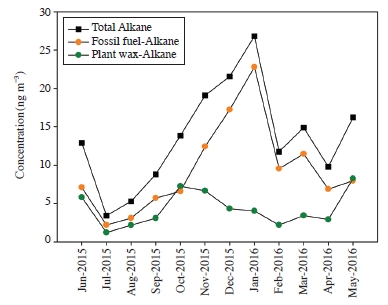
Monthly variation of total n-alkane, fossil fuel derived n-alkanes and plant wax derived n-alkanes concentrations.
∑n-Alkanes의 계절 분포는 겨울에 높고 여름에 낮은 특성을 보였고, 이는 안면도의 기온 분포 (그림 3)와 같이 낮은 기온을 보이는 겨울 동안 난방 연소가 많아짐에 따라 난방 사용이 적은 여름과의 차이에서 비롯된 것으로 예상된다. 서울에서의 ∑n-alkanes의 계절 특성도 겨울에 높고 여름에 낮은 형태로 보고되었고, 주요원인으로는 겨울의 난방 연소에 의한 영향으로 해석하였다 (Lee et al., 2015).
n-Alkane의 인위적 배출과 자연적 생성의 기여도를 파악하기 위하여 plant wax에서 비롯된 n-alkane (PW)을 계산하였고, 이를 제외한 n-alkane을 연료의 연소에서 기인한 배출 (FF)로 고려하였다 (Wang et al., 2009b; Simoneit et al., 2004b, 1991). PW와 FF의 월별 분포 (그림 2)를 살펴보면 두 분포의 추이는 상이하게 나타났다. FF은 n-alkanes의 월별 농도와 비슷한 분포를 보였고, 11월부터 3월까지 높은 농도를 나타내었다. 반면 PW은 FF에 비해 월별 변화가 뚜렷하지 않았다.
3. 2 n-alkane 성분들의 탄소수에 따른 농도 분포 특성
n-Alkanes은 배출원 특성에 따라 성분들의 탄소수에 따른 농도 분포가 다르게 나타나는 특징이 있다. 일반적으로 C<25의 n-alkane 성분들은 주로 화석연료 또는 바이오매스의 연소에서 배출되는 반면 C>27의 n-alkane 성분들은 식물로부터 기원한다고 보고되고 있다 (Sicre and Peltzer, 2004; Simoneit et al., 2004a; Rogge et al., 1997, 1993; Zheng et al., 1997; Simoneit et al., 1989). 또한, 화석연료와 바이오매스 연소에서 기인된 n-alkane들은 짝수와 홀수 탄소수를 가진 성분들의 배출 분포가 선택적이지 않기 때문에 CPI값이 거의 1에 가까운 반면, 식물로부터 기인한 경우에는 C27와 C29, C31 등의 홀수의 탄소수를 가진 성분들이 우세하기 때문에 CPI는 5에서 10까지 범위의 큰 값을 보인다 (Schmidl et al., 2008a, b; Wang and Kawamura, 2005; Didyk et al., 2000; Fang et al., 1999; Standley and Simoneit, 1987; Simoneit, 1984; Eglington and Hamilton, 1967).
그림 4은 C20부터 C34까지 개별 n-alkane 성분들의 비율을 보여주고 있다. 식물 배출의 영향이 큰 C27과 C29, C31의 성분들의 비율은 2015년 6월부터 10월까지 증가하는 추세를 보이면서 11월부터 2016년 3월까지는 낮고, 다른 성분들과 큰 차이를 보이지 않다가, 2016년 4월과 5월에 다시 높아지는 특징을 보였다. 이는 이 시기에 활발한 식물 성장이 안면도 대기 중 PM2.5 내 n-alkane의 농도에 영향을 미친 것으로 판단된다. 반면, 대기 온도가 낮아지고, 난방에 의한 화석연료 사용량이 증가하는 2015년 11월부터 2016년 3월까지는 C≤25의 성분들의 농도가 뚜렷하게 증가하였다. 이는 앞에서 설명한 바와 같이 이 기간 동안 난방에 의한 인위적 연소 배출에 의한 영향으로 판단된다.
안면도 대기 중 PM2.5 내 n-alkane은 11월부터 그 다음해 3월까지와 4월부터 10월까지 서로 각각 다른 배출 패턴이 보이는 것을 확인하였다. 서로 다른 배출 패턴이 보이는 요인이 난방 사용과의 관련성이 있는지를 확인해 보기 위해 측정 기간 동안의 기온 분포 (그림 3)를 살펴본 결과, 11월부터 3월까지 난방기준온도 이하의 온도를 보였고, 총 에너지 소비 분포는 월별 편차가 크지는 않았지만 11월부터 3월까지 증가하는 것을 확인하였다 (KEEI, 2017; Park and Song, 2017; KMA, 2015). 이와 같은 결과들을 토대로 11월부터 3월까지를 난방기간, 4월부터 10월까지를 비난방기간으로 구분하였다.
난방기간에 화석연료 또는 바이오매스 연소와 같은 인위적 배출이 ∑n-alkanes의 증가요인인지를 파악하기 위하여, n-alkane 성분들의 탄소수별 농도를 난방기간과 비난방기간으로 구분지어 나타냈다 (그림 5). 안면도에서 C20부터 C25까지의 n-alkane 성분들의 농도는 난방기간이 비난방기간에 비해 약 5배 높았다. 반면, C26에서 C34의 n-alkane 성분들의 농도는 두 기간에 유사한 농도와 비율을 나타냈다. 이는 난방기간에 연료 연소에 기인한 인위적 배출의 영향이 커지는 반면, 비난방기간에는 자연적 생성의 영향이 커지는 것으로 해석할 수 있다. 이러한 탄소수 분포에 대한 양상을 보았을 때, 난방기간에 화석연료를 포함한 인위적 연소로 인한 영향이 두드러지는 것으로 판단된다.
3. 3 지표 값들에 의한 배출원 기여도 평가
서론에서 설명한 바와 같이 n-alkane은 탄소수의 농도 분포에 따라 Cmax와 CPI, WNA%를 산출할 수 있다. 기존 연구결과들에 의하면 Cmax가 낮을수록 연료 연소 배출의 영향이 크고, Cmax가 높을수록 plant wax에 의한 영향이 크다고 보고하였다 (Simoneit et al., 1991; Mazurek and Simoneit, 1984). 그림 4에 제시한 바와 같이 안면도의 Cmax는 월별 분포가 다르게 나타났다. 2015년 6월부터 11월, 2016년 3월부터 5월까지는 C27~31 범위의 높은 Cmax를 가지며, 2015년 12월부터 2016년 2월까지는 C23~25의 범위로 낮은 Cmax를 가졌다. 서울 연구결과 (Lee et al., 2015)를 비교해보면 서울에서 측정된 n-alkane 성분들의 Cmax는 8~9월과 12월을 제외한 모든 달에 C29로 일정하게 나타났고 8~9월, 12월도 C29와 같이 탄소 수가 많은 Cmax를 가졌다는 것을 통해 서울에서는 모든 기간에 일정한 배출원 특성을 보였다고 보고되었다. 반면, 안면도에서는 기간별 Cmax이 차이를 보였고, 이는 기간별 배출 특성이 다르고, C23~25의 범위로 낮은 Cmax를 가지는 12월~2월에는 인위적 배출의 영향이 두드러진 것으로 판단된다.
CPI의 값이 1에 가까울수록 인위적 배출의 영향이 지배적이고, 3보다 큰 경우 자연적 배출의 영향이 지배적이라고 보고되고 있다 (Mazurek et al., 1989; Simoneit et al., 1989; Eichmann et al., 1979). 또한 n-alkanes의 농도 중 plant wax에 기인하는 농도의 기여도를 파악할 수 있는 지표로서, WNA%를 계산하였다 (Bi et al., 2003; Simoneit et al., 1991; Simoneit, 1989). 이와 같이 계산된 CPI와 WNA%를 표 2에 정리하였다. 본 연구에서 안면도의 CPI 평균은 2.18±1.20, 범위는 1.16~8.59였다. 난방기간의 CPI값은 1.69, 비난방기간에는 2.54로 난방기간에 비해 높은 CPI값을 가지는 것을 볼 수 있다. CPI의 월별 분포 (그림 6)를 살펴보면, 안면도의 CPI는 10월부터 1월까지 감소하다가 2월부터 다시 증가하는 경향을 보였다.
본 연구결과를 서울에서 수행한 선행 연구와 비교해 본 결과, 서울 대기 중 PM10의 CPI 평균은 1.95±0.82로 본 연구와 유사한 수준을 나타냈지만, 범위는 1.17~2.60으로 본 연구에 비해 상대적으로 좁은 범위를 나타내었다. 또한 난방기간의 CPI값은 1.72, 비난방기간의 CPI값은 2.09로, 서울에서의 난방기간 동안의 CPI값은 본 연구의 값 (CPI=1.69)과 비슷하였다 (Lee et al., 2015).
본 연구에서 계산한 측정 기간 동안의 n-alkane에 대한 평균 WNA%는 32.0±16.0으로 계산되었다. WNA%를 월별로 살펴보면 (그림 7), 53.7%로 가장 높은 값을 가지는 10월은 그 다음 년도의 1월 (15.7%)까지 감소하며 가장 낮은 수치를 기록하다가 5월에 크게 증가하는 경향을 보인다. 또한 비난방기간에는 38.7±16.0%, 난방기간은 23.0±10.8%로 비난방기간에 plant wax의 기여율이 약 40% 크게 나타났다.
그림 8에는 CPI와 WNA% 사이의 상관관계 (r= 0.90)를 제시하였다. CPI와 WNA%의 상관관계가 높다는 것은 두 지표의 배출원 기여도 평가에 대한 일관성을 제시함으로써 두 지표가 배출원 식별에 효과적이라는 통계적 증거를 제공한다 (Górka et al., 2014; He et al., 2010; Wu et al., 2005; Gogou et al., 1996). 이를 통해 본 연구에서 n-alkanes의 지표 값들이 n-alkanes의 배출 특성을 파악하기 위해 적절하다고 판단된다.
3. 4 주성분 분석을 통한 배출원 기여도 평가
대기오염물질의 오염원 추정에 많이 사용되는 PCA를 이용하여 안면도 대기 중 PM2.5 내 n-alkanes의 배출원 기여도를 평가하였다 (Fang et al., 2004; Kalaitzoglou et al., 2004; Liu et al., 2003; Hopke et al., 1976). PCA 분석은 SPSS Statistics 24 프로그램을 이용하여 처리하였고, 고유치가 1.0 이상을 기준으로 주성분 수를 결정하였다. 또한 각 인자에 대한 물리적 해석을 용이하게 하기 위해 Varimax 회전법을 이용하였고 요인적재량을 산출하였다. 표 3에 안면도 대기 중 n-alkane의 주성분 분석결과를 정리하였다. 안면도 대기 중 n-alkanes의 농도에서는 세 개의 주성분이 추출되었고, 이들은 전체의 93.6%를 설명하였다. 주성분 1은 총 분산의 42.3%로서 C20~26인 탄소수가 적거나 중간 정도의 n-alkane의 성분들의 개수가 높았으며, 이는 앞 절에서 설명한 바와 같이 연료 연소에 기인한 인위적 배출 영향으로 해석된다 (Duan et al., 2010; Wang et al., 2009a; Sicre and Peltzer, 2004; Simoneit et al. 2004a; Rogge et al., 1997, 1993; Zheng 1997; Simoneit, 1989). 주성분 2는 총 분산의 28.29%로서 탄소수가 많은 n-alkane 성분들 중 짝수로 구성된 C28, C30, C32, C34의 성분들이 홀수 성분들과 구분되어 (주성분 3) 추출되었다. 일부 문헌 (Mitra et al., 2002; Cass, 1998)에서는 탄소수가 많은 짝수 n-alkane은 자동차 타이어가 마모됨에 따라 배출된다고 보고하였지만, 이는 앞 절에서 보인 안면도 대기 중 n-alkanes의 배출 특성과 일관성 있게 나타나지 않는다. 그럼에도 불구하고, 요인분석에서 별도의 요인으로 구분된 것은 안면도 대기 중 n-alkanes의 또 다른 특성으로 판단되고, 추후 주성분 2를 보다 정확하게 설명할 수 있는 배출 특성을 구분할 수 있는 추가적인 화학성분 분석이 필요하다. 주성분 3은 총 분산의 22.97%로서 탄소수가 많은 홀수 n-alkane인 C27, C29, C31, C33의 성분들이 주요성분들로 추출되었다. 이는 plant wax와 같은 자연적 생성으로 해석된다.
4. 요약 및 결론
본 연구에서는 2015년 6월부터 2016년 5월까지 안면도에서 측정한 대기 PM2.5 내 n-alkanes의 농도분포를 바탕으로 PM2.5 내 탄소입자들의 배출 특성을 파악하였다. 본 연구에서 측정한 n-alkanes의 총 농도의 평균은 14.02±10.26 ng m-3로 11월부터 농도가 증가하여 1월에 최고치 (26.82±11.77 ng m-3)를 보였다. 반면 최저 농도는 7월 (3.43±2.17 ng m-3)로 나타나면서 4월부터 10월까지는 낮은 농도 수준을 유지하였다. 안면도 대기 중 PM2.5 내 n-alkanes의 농도는 일반적으로 화석연료의 연소 배출에 영향을 받는 성분들과 유사한 계절별 농도 특성을 보였지만, 겨울철 농도가 여름철 농도에 비해 약 2배 정도 높은 수준으로 계절별 농도 차이는 크지 않은 특성을 보였다. n-Alkanes의 월별 농도 분포 특성과 대기 중 온도, 국내 총 에너지 소비량을 바탕으로 11월부터 3월까지를 난방기간으로 4월부터 10월까지를 비난방기간으로 구분하여 두 기간의 n-alkanes 농도 분포를 비교하였다. 비난방기간에는 C27와 C29, C31, C33들의 n-alkane 농도가 증가하였고, 이는 활발한 식물성장으로 인한 영향으로 판단하였다. 난방기간에는 탄소수가 적은 n-alkane 성분들의 농도가 높았고, 이는 화석연료 또는 바이오매스 연소에 기인한 인위적 배출 영향으로 해석된다. 안면도 대기 중 n-alkanes의 Cmax 분포는 2015년 6월부터 11월, 2016년 3월부터 5월까지는 C27부터 C31까지 범위의 탄소수가 많은 n-alkane 성분들이 Cmax를 보였고, 이는 plant wax의 영향에서 기인하였다. 반면, 2015년 12월부터 2016년 2월까지는 n-alkane 성분들은 C23에서 C25까지 범위의 낮은 Cmax를 나타냈고, 이는 인위적인 배출 영향을 나타냈다. 탄소 선호 지수를 나타내는 CPI 평균은 2.18±1.20로 1.16~8.59의 범위를 가졌고, 난방기간의 CPI값은 1.69, 비난방기간에는 2.54로 난방기간에 비해 높은 CPI값을 보이는 것을 확인하였다. n-Alkane에 대한 평균 WNA%는 32.0±16.0으로 계산되었으며, 비난방기간 (38.7±16.0)은 난방기간 (23.0±10.8)보다 plant wax의 기여율이 약 40% 정도 크게 나타났다. 이러한 진단 지표를 통해 안면도는 비난방기간에 자연적 생성의 영향이 크며, 난방기간에는 화석연료 및 바이오매스 연소 등에 기인한 인위적 배출원의 영향이 크다고 판단된다. 또한 안면도에서 측정한 n-alkanes 배출원의 기여도를 평가하기 위한 주성분 분석 결과로 세 개의 주성분이 추출되었고 이는 전체의 93.6%를 설명하였다. 총 n-alkane 농도의 42.3%를 차지하는 주성분 1은 연료 연소에 기인한 인위적 영향으로 해석되었고, 주성분 3 (22.97%)은 plant wax와 같은 자연적 발생에서 기인한 것으로 판단되었다.
Acknowledgments
이 논문은 2017학년도 조선대학교 학술연구비 지원으로 수행되었습니다.
References
-
Bi, X., Sheng, G., Peng, P.A., Chen, Y., Zhang, Z., Fu, J., (2003), Distribution of particulate-and vapor-phase n-alkanes and polycyclic aromatic hydrocarbons in urban atmosphere of Guangzhou, China, Atmospheric Environment, 37(2), p289-298.
[https://doi.org/10.1016/s1352-2310(02)00832-4]

-
Cass, G.R., (1998), Organic molecular tracers for particulate air pollution sources, TrAC Trends in Analytical Chemistry, 17(6), p356-366.
[https://doi.org/10.1016/s0165-9936(98)00040-5]

- Didyk, B.M., Simoneit, B.R., Pezoa, L.A., Riveros, M.L., Flores, A.A., (2000), Urban aerosol particles of Santiago, Chile: organic content and molecular characterization, Atmospheric Environment, 34(8), p1167-1179.
-
Duan, F., He, K., Liu, X., (2010), Characteristics and source identification of fine particulate n-alkanes in Beijing, China, Journal of Environmental Sciences, 22(7), p998-1005.
[https://doi.org/10.1016/s1001-0742(09)60210-2]

-
Eglinton, G., Hamilton, R.J., (1967), Leaf epicuticular waxes, Science, 156(3780), p1322-1335.
[https://doi.org/10.1126/science.156.3780.1322]

-
Eichmann, R., Neuling, P., Ketseridis, G., Hahn, J., Jaenicke, R., Junge, C., (1979), n-Alkane studies in the troposphere-I. Gas and particulate concentrations in North Atlantic air, Atmospheric Environment, 13(5), p587-599.
[https://doi.org/10.1016/0004-6981(79)90187-2]

-
Fang, G.C., Wu, Y.S., Chen, M.H., Ho, T.T., Huang, S.H., Rau, J.Y., (2004), Polycyclic aromatic hydrocarbons study in Taichung, Taiwan, during 2002~2003, Atmospheric Environment, 38(21), p3385-3391.
[https://doi.org/10.1016/s1352-2310(04)00308-5]

- Fang, M., Zheng, M., Wang, F., To, K.L., Jaafar, A.B., Tong, S.L., (1999), The solvent-extractable organic compounds in the Indonesia biomass burning aerosols-characterization studies, Atmospheric Environment, 33(5), p783-795.
-
Fraser, M.P., Cass, G.R., Simoneit, B.R., (1999), Particulate organic compounds emitted from motor vehicle exhaust and in the urban atmosphere, Atmospheric Environment, 33(17), p2715-2724.
[https://doi.org/10.1016/s1352-2310(98)00311-2]

-
Gogou, A., Stratigakis, N., Kanakidou, M., Stephanou, E.G., (1996), Organic aerosols in Eastern Mediterranean: components source reconciliation by using molecular markers and atmospheric back trajectories, Organic Geochemistry, 25(1), p79-96.
[https://doi.org/10.1016/s0146-6380(96)00105-2]

-
Górka, M., Rybicki, M., Simoneit, B.R., Marynowski, L., (2014), Determination of multiple organic matter sources in aerosol PM10 from Wrocław, Poland using molecular and stable carbon isotope compositions, Atmospheric Environment, 89, p739-748.
[https://doi.org/10.1016/j.atmosenv.2014.02.064]

-
He, J., Zielinska, B., Balasubramanian, R., (2010), Composition of semi-volatile organic compounds in the urban atmosphere of Singapore: influence of biomass burning, Atmospheric Chemistry and Physics, 10(23), p11401-11413.
[https://doi.org/10.5194/acp-10-11401-2010]

-
Hopke, P.K., Gladney, E.S., Gordon, G.E., Zoller, W.H., Jones, A.G., (1976), The use of multivariate analysis to identify sources of selected elements in the Boston urban aerosol, Atmospheric Environment (1967), 10(11), p1015-1025.
[https://doi.org/10.1016/0004-6981(76)90211-0]

-
Kadowaki, S., (1994), Characterization of carbonaceous aerosols in the Nagoya urban area. 2. Behavior and origin of particulate n-alkanes, Environmental science & technology, 28(1), p129-135.
[https://doi.org/10.1021/es00050a017]

-
Kalaitzoglou, M., Terzi, E., Samara, C., (2004), Patterns and sources of particle-phase aliphatic and polycyclic aromatic hydrocarbons in urban and rural sites of western Greece, Atmospheric Environment, 38(16), p2545-2560.
[https://doi.org/10.1016/j.atmosenv.2004.01.042]

- Korea Energy Economics Institute (KEEI), (2017), Monthly Energy Statistics, 33(09), p3-64.
- Korea Meteorological Administration (KMA), (2015), Anmyeon Island meteorological administration weather data.
- Lee, S.P., Lim, H.B., Lee, J.Y., Kim, Y.P., (2015), Seasonal Variation of Concentrations and Sources for n-alkanes in PM10 Measured in Seoul, Journal of Korea Society for Environmental Analysis, 18(2), p93-100, (in Korean with English abstract).
-
Limbeck, A., Puxbaum, H., (1999), Organic acids in continental background aerosols, Atmospheric Environment, 33(12), p1847-1852.
[https://doi.org/10.1016/s1352-2310(98)00347-1]

-
Liu, Q.T., Chen, R., McCarry, B.E., Diamond, M.L., Bahavar, B., (2003), Characterization of polar organic compounds in the organic film on indoor and outdoor glass windows, Environmental science & technology, 37(11), p2340-2349.
[https://doi.org/10.1021/es020848i]

- Mazurek, M.A., Simoneit, B.R.T., (1984), Characterization of biogenic and petroleum-derived organic matter in aerosols over remote, rural and urban areas, Identification and analysis of organic pollutants in air, 22, p353.
-
Mazurek, M.A., Cass, G.R., Simoneit, B.R., (1989), Interpretation of high-resolution gas chromatography and high-resolution gas chromatography/mass spectrometry data acquired from atmospheric organic aerosol samples, Aerosol Science and Technology, 10(2), p408-420.
[https://doi.org/10.1080/02786828908959280]

-
Mitra, A.P., Morawska, L., Sharma, C., Zhang, J., (2002), Chapter two: methodologies for characterisation of combustion sources and for quantification of their emissions, Chemosphere, 49(9), p903-922.
[https://doi.org/10.1016/s0045-6535(02)00236-9]

- Park, S.M., Song, D.S., (2017), A Study on Generating Process of Regional Balance Point Temperature for Heating Degree-days in Korea, Korean Journal of Air-Conditioning and Refrigeration Engineering, 29(9), p482-495, (in Korean with English abstract).
-
Rogge, W.F., Hildemann, L.M., Mazurek, M.A., Cass, G.R., Simoneit, B.R., (1993), Sources of fine organic aerosol. 4. Particulate abrasion products from leaf surfaces of urban plants, Environmental Science & Technology, 27(13), p2700-2711.
[https://doi.org/10.1021/es00049a008]

-
Rogge, W.F., Hildemann, L.M., Mazurek, M.A., Cass, G.R., Simoneit, B.R., (1997), Sources of fine organic aerosol. 8. Boilers burning No. 2 distillate fuel oil, Environmental science & technology, 31(10), p2731-2737.
[https://doi.org/10.1021/es9609563]

-
Schmidl, C., Bauer, H., Dattler, A., Hitzenberger, R., Weissenboeck, G., Marr, I.L., Puxbaum, H., (2008a), Chemical characterisation of particle emissions from burning leaves, Atmospheric Environment, 42(40), p9070-9079.
[https://doi.org/10.1016/j.atmosenv.2008.09.010]

-
Schmidl, C., Marr, I.L., Caseiro, A., Kotianová, P., Berner, A., Bauer, H., Kasper-Giebl, A., Puxbaum, H., (2008b), Chemical characterisation of fine particle emissions from wood stove combustion of common woods growing in mid-European Alpine regions, Atmospheric Environment, 42(1), p126-141.
[https://doi.org/10.1016/j.atmosenv.2007.09.028]

-
Simoneit, B.R.T., (1977), Organic matter in eolian dusts over the Atlantic Ocean, Marine Chemistry, 5(4-6), p443-464.
[https://doi.org/10.1016/0304-4203(77)90034-2]

- Simoneit, B.R.T., Eglinton, G., (1977), Organic matter of eolian dust and its input to marine sediments, Advances in organic geochemistry, p415-430.
-
Simoneit, B.R., (1984), Organic matter of the troposphere-III. Characterization and sources of petroleum and pyrogenic residues in aerosols over the western United States, Atmospheric Environment (1967), 18(1), p51-67.
[https://doi.org/10.1016/0004-6981(84)90228-2]

-
Simoneit, B.R.T., (1989), Organic matter of the troposphere-V: application of molecular marker analysis to biogenic emissions into the troposphere for source reconciliations, Journal of Atmospheric Chemistry, 8(3), p251-275.
[https://doi.org/10.1007/bf00051497]

-
Simoneit, B.R., Sheng, G., Chen, X., Fu, J., Zhang, J., Xu, Y., (1991), Molecular marker study of extractable organic matter in aerosols from urban areas of China, Atmospheric Environment. Part A. General Topics, 25(10), p2111-2129.
[https://doi.org/10.1016/0960-1686(91)90088-o]

- Simoneit, B.R., Kobayashi, M., Mochida, M., Kawamura, K., Huebert, B.J., (2004a), Aerosol particles collected on aircraft flights over the northwestern Pacific region during the ACE-Asia campaign: Composition and major sources of the organic compounds, Journal of Geophysical Research: Atmospheres, 109(D19).
- Simoneit, B.R., Kobayashi, M., Mochida, M., Kawamura, K., Lee, M., Lim, H.J., Turpin, B.J., Komazaki, Y., (2004b), Composition and major sources of organic compounds of aerosol particulate matter sampled during the ACE-Asia campaign, Journal of Geophysical Research: Atmospheres, 109(D19).
-
Standley, L.J., Simoneit, B.R., (1987), Characterization of extractable plant wax, resin, and thermally matured components in smoke particles from prescribed burns, Environmental science & technology, 21(2), p163-169.
[https://doi.org/10.1021/es00156a006]

-
Sicre, M.A., Peltzer, E.T., (2004), Lipid geochemistry of remote aerosols from the southwestern Pacific Ocean sector, Atmospheric Environment, 38(11), p1615-1624.
[https://doi.org/10.1016/j.atmosenv.2003.12.012]

-
Wang, G., Kawamura, K., (2005), Molecular characteristics of urban organic aerosols from Nanjing: A case study of a mega-city in China, Environmental science & technology, 39(19), p7430-7438.
[https://doi.org/10.1021/es051055+]

- Wang, G., Kawamura, K., Xie, M., Hu, S., Gao, S., Cao, J., An, Z., Wang, Z., (2009a), Size-distributions of n-alkanes, PAHs and hopanes and their sources in the urban, mountain and marine atmospheres over East Asia, Atmospheric Chemistry and Physics, 9(22), p8869-8882.
-
Wang, G., Kawamura, K., Lee, M., (2009b), Comparison of organic compositions in dust storm and normal aerosol samples collected at Gosan, Jeju Island, during spring 2005, Atmospheric Environment, 43(2), p219-227.
[https://doi.org/10.1016/j.atmosenv.2008.09.046]

-
Wu, S.P., Tao, S., Zhang, Z.H., Lan, T., Zuo, Q., (2005), Distribution of particle-phase hydrocarbons, PAHs and OCPs in Tianjin, China, Atmospheric Environment, 39(38), p7420-7432.
[https://doi.org/10.1016/j.atmosenv.2005.08.031]

- Yamamoto, S., Kawamura, K., (2011), Stable hydrogen isotope ratios of n-alkanes in atmospheric aerosols from Okinawa, Japan, Researches in organic geochemistry, 27, p81-89.
-
Yassaa, N., Meklati, B.Y., Cecinato, A., Marino, F., (2001), Particulate n-alkanes, n-alkanoic acids and polycyclic aromatic hydrocarbons in the atmosphere of Algiers City Area, Atmospheric Environment, 35(10), p1843-1851.
[https://doi.org/10.1016/s1352-2310(00)00514-8]

-
Zheng, M., Wan, T.S.M., Fang, M., Wang, F., (1997), Characterization of the non-volatile organic compounds in the aerosols of Hong Kong-identification, abundance and origin, Atmospheric Environment, 31(2), p227-237.
[https://doi.org/10.1016/1352-2310(96)00173-2]

-
Zheng, M., Fang, M., Wang, F., To, K.L., (2000), Characterization of the solvent extractable organic compounds in PM2.5 aerosols in Hong Kong, Atmospheric Environment, 34(17), p2691-2702.
[https://doi.org/10.1016/s1352-2310(99)00521-x]

